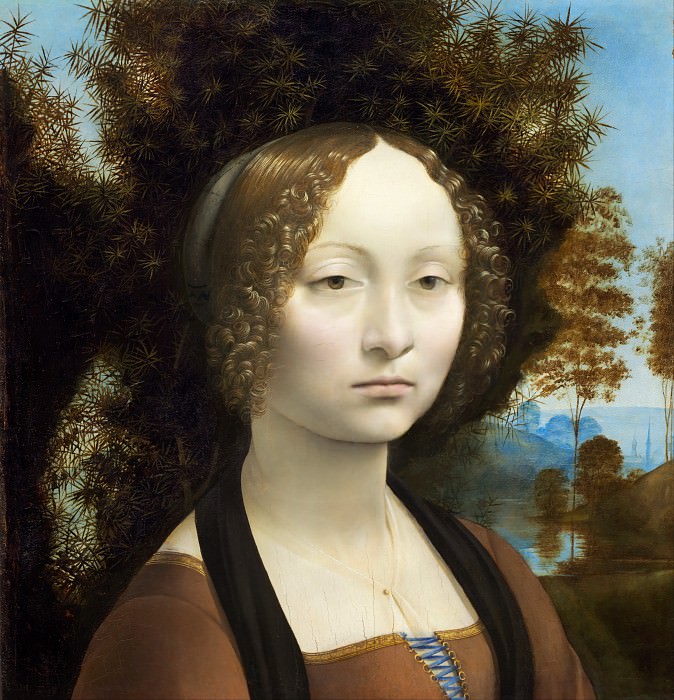Portrait of Ginevra Benci Leonardo da Vinci (1452-1519)
Leonardo da Vinci – Portrait of Ginevra Benci
Edit attribution
Download full size: 4907×5100 px (5,9 Mb)
Painter: Leonardo da Vinci
Leonardo Da Vinci’s Portrait of Genevra de Benchi belongs to the artist’s early work. The artist painted women very often, this is one of the distinctive features of his work. In addition, facial features are drawn so clearly and vividly that it’s not difficult to guess the thoughts and feelings of sitters. The same applies to this painting. It depicts Ginevra d’Amerigo de Benci, poetess of Florence in the late 15th century.
Description of Leonardo da Vinci’s Portrait of Genevra de Benchi
Leonardo Da Vinci’s Portrait of Genevra de Benchi belongs to the artist’s early work. The artist painted women very often, this is one of the distinctive features of his work. In addition, facial features are drawn so clearly and vividly that it’s not difficult to guess the thoughts and feelings of sitters.
The same applies to this painting. It depicts Ginevra d’Amerigo de Benci, poetess of Florence in the late 15th century. As researchers and experts believe, this may be one of the first psychological portraits of the time, in which the mood of sadness is particularly pronounced.
According to the assumption, this is due to the fact that the girl not so long ago experienced the parting with the Venetian ambassador Bernardo Bembo. This feeling is particularly emphasized by the play of light and shadows, skilfully performed by Leonardo da Vinci. The focus is on the pale face of the girl, her eyes and her broad cheekbones, which stand out especially against the dark background of the landscape depicted in the background. The sadness of the girl is further emphasized by the slightly blurred contours of her body - this is a special technique called sfumato.
Leonardo Da Vinci introduced quite a number of innovations in pictorial technique, and in this painting he also applied something that was not quite typical of Italian Renaissance portraits. For example, Ginevra’s face is turned to the right instead of to the left, as was common in the tradition of portraiture.
Experts are still arguing about this painting today. Some of them believe that Ginevra’s portrait is cut off, that is, the girl must still have her hands visible. This is connected with the thesis of Leonardo, in which he wrote that people are best depicted with hands, because they most fully characterize the human condition and his inner world.
In addition, in the collection of Windsor Castle there is a drawing preserved of a woman’s hands, the proportions of which remarkably correspond to Ginevra’s portrait. Who knows, maybe this is the continuation of the painting.
Кому понравилось
Пожалуйста, подождите
На эту операцию может потребоваться несколько секунд.
Информация появится в новом окне,
если открытие новых окон не запрещено в настройках вашего браузера.
You need to login
Для работы с коллекциями – пожалуйста, войдите в аккаунт (open in new window).




















You cannot comment Why?
Behind her, on the left, is a dense, dark mass of juniper branches, rendered with meticulous detail, symbolizing perhaps purity or chastity (as the juniper was associated with these). The background transitions into a hazy, atmospheric landscape, featuring trees, water, and distant blue hills and buildings, characteristic of Leonardos sfumato technique, which creates soft, blurred transitions between colors and tones.
The subtexts of the painting are multi-layered. Ginevra de Benci was a Florentine noblewoman, celebrated for her beauty and intellect. The portrait is believed to have been commissioned to commemorate her marriage, or perhaps her engagement. The dark, somewhat somber expression of Ginevra could be interpreted as a reflection of the limitations placed upon women of her era, or perhaps a personal melancholy. The juniper branches, as mentioned, are a strong symbol, possibly alluding to her virtue and untouched nature, or perhaps even her surname, Benci, which sounds similar to the Italian word for juniper, ginepro. The landscape in the background, while beautiful, is rendered with a distance and haziness that could suggest the ephemeral nature of beauty or life itself, or perhaps represents an idealized inner world contrasting with the more direct representation of the sitter. Her averted gaze, rather than directly engaging the viewer, adds to the sense of introspection and mystery surrounding her character.